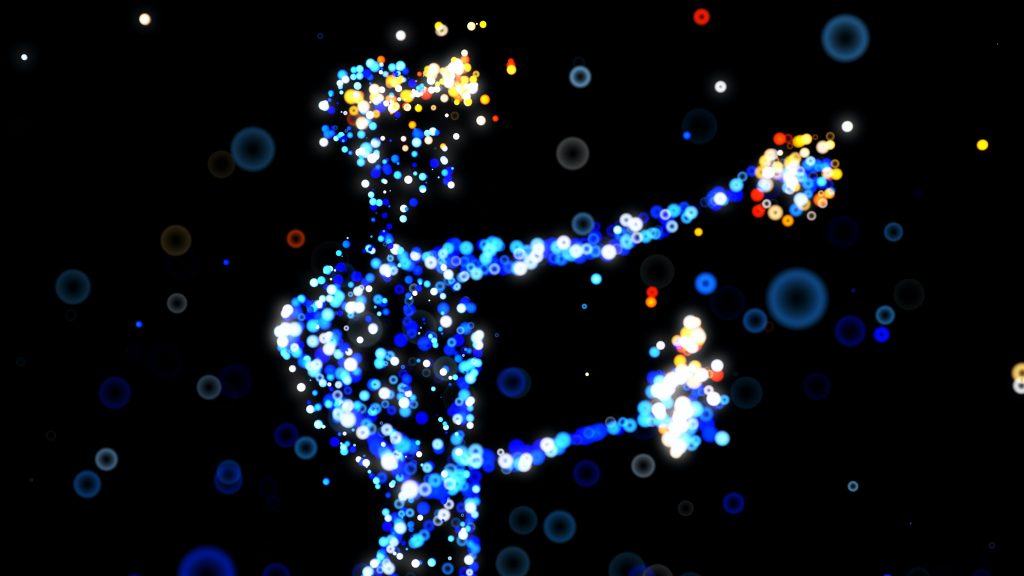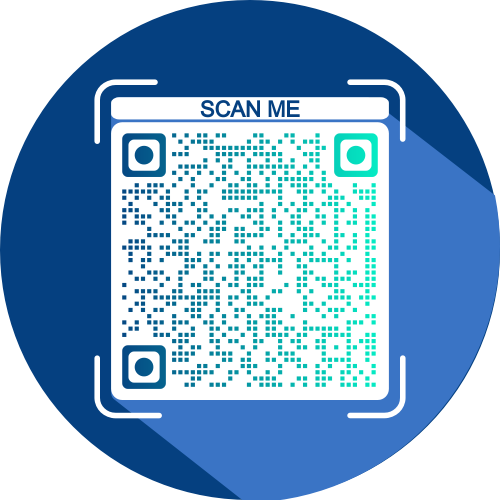
Here, There, and Everywhere…simultaneously
Tromeur, J. (2021, November 23). The Metaverse [Photograph]. Unsplash. Retrieved from https://unsplash.com/photos/EOSHmMbjT8g
Working in a library has given me the added benefit of having already used some of this week’s tools. We use QR codes quite frequently to quickly redirect patrons to various content such as our website, social media, program registration, and library contests. My first experience with creating a QR (Quick Response) code was for a homeschool parent survey I created in Google Docs. While the same survey was available in paper format, parents found it easier and more convenient to scan the QR code and complete the survey. The added bonus for me was that Google collected the answers, tabulated the results, and made amazing graphs so I could easily analyze the data. I currently have a QR code on a flyer for people to scan which will bring them to a list of various favorite homeschool websites compiled by the families who visit our library. Daily we have children asking for a lengthy list of specific subject area books such as unicorn, superhero, princess, and motor cross. Composing QR codes to show the author, title and location for the popular subjects would “easily redirect students to engaging and informative information about [our] library without spending or typing for it on the internet” (Kharbach, 2022).

On her website, The Educators Spin On It, Kim Vij has posted 30+ VR field trips. The first one I took was to the Austrian Alps. Taking a gondola up, and skiing back down was somewhat boring. The audio was awful; I muted it. There was not much to this trip. Next, I cruised over to Switzerland. Click on the QR code and you can too! In this field trip we join Martin Anje who skates on thin ice. The sounds of the blades are particularly intriguing, musical, and otherworldly. Along the way are educational blurbs. A worksheet can be printed for follow up responses.
Vij, K. (n.d.). Winter virtual field trips for kids. The Educator’s Spin On It. Retrieved from https://theeducatorsspinonit.com/?s=virtual+field+trips

Google’s Arts +Culture website has some incredible field trips. Scan the QR code to take a field trip to Underwater Caribbean. Each slide has a brief one sentence description. Some slides give the ability to zoom in or use arrows to give a more 180 degree browse. I expected audio. To be more inclusive and even add interest to the trip, having the choice to turn on audio would be an added benefit.
Access to information is at the heart of a library’s mission. Before the days of the internet, I remember having to call our local library so the librarian could look up an an answer only found in an encyclopedia. My parents had not invested in a set from the traveling salesman!
Today access has trolled beyond the limits of time and space. Information that at one time seemed only available in the pages of a book, or more recently, on a web site, can now be accessed through augmented reality. The most impactful AR tool to me this week was the double robot used by Jasmine, a homebound student. Through the use of the double robot, Jasmine had access to school and access to friends. Her mom explained, “It was a whole new world for her” (Double Robotics, 2015). Jasmine’s face appears on a screen. She maneuvers the double bot through the school hallways and classrooms using her mouse pad on her computer from the comfort of home. Jasmine now ‘goes’ to school each day.
StarLab is a traveling planetarium. StarLab “allow[s] students to explore coral reefs, observe wildlife and learn about the solar system” (Hager, 2019) without the field trip expense and time limitations. It can all take place within the classroom. The limiting factors of time, money, and practicality are dramatically reduced.
“Virtual experiences have the power to engage and inspire students in a unique and powerful way” (Immersion VR, n.d.). Topics of study which in the past may have seemed boring or unrelatable, now “allow students to imagine a location with a realistic experience often help[ing] to get them interested in a subject” (Immersion VR, n.d.).
I can see virtual field trips being added to our programs for school age children. This type of connection would help them to understand and relate to certain literature in a more meaningful and educational way. I would also like to see our YA librarian venture in to VR programs. They would certainly attract a larger tween/teen crowd. Including the educational benefits of VR in a library’s marketing could be very persuasive.
Immersion VR Benefits
1. Students learn better through experience
VR provides students an opportunity to learn through experience, in contrast to the traditional methods of reading and writing.
2. VR has the ability to inspire
Being able to see and experience extraordinary locations within the classroom is completely unique to VR and it is inspirational to students.
3. VR sparks the imagination and encourages creative thinking
The immersive experience that VR provides is unparalleled in teaching. Students are “transported” out of the classroom and their imagination is allowed to flourish.
4. VR in education promotes peer interaction
Throughout the VR experience, students are encouraged to interact with each other. Afterwards, they are eager to share their thoughts and discuss their experiences.
5. VR engages students
Many students get bored with classic teaching methods. The modern technology of VR gets students’ attention like nothing else. We find that students instantly want to try out the VR.
6. VR provides realistic travel experiences
Using VR, schools can provide students with travel experiences that would not be possible or practical. Schools can save time and money whilst providing students with incredible experiences.
7. VR in the classroom is inclusive
With VR, every student gets the same opportunity to enjoy the experience. Unlike traditional school trips that can be too expensive for parents or too impractical for their children, VR is for all students.
8. VR offers memorable educational experiences
Long after the VR has finished, students remember the experience and they are eager to reflect on it in future lessons.
References
Double Robotics. (2015, June 17). Case study: Sebasticook Valley Middle School Middle School + Double Robotics. Retrieved from https://www.YouTube.com/watch?v=aln1V0rtCkE
Google Arts & Culture. (n.d.). Underwater Caribbean. Retrieved November 10, 2022, from https://artsandculture.google.com/story/hAXhOgP8F5uzUA
Hager, J. (2019, February 14). StarLab makes its way to Richmond County schools. Richmond County Daily Journal. Retrieved from https://www.yourdailyjournal.com/news/85221/starlab-makes-its-way-to-richmond-county-schools
Immersion VR. (n.d.). VR for education. Retrieved from https://immersionvr.co.uk/about-360vr/vr-for-education/#contact-details
Kharbach, M. (2020, June 12). 10 ways to use QR codes in online education. Educational Technology and Mobile Learning. https://www.educatorstechnology.com/2020/06/10-ways-to-use-qr-codes-in-online.html
National Geographic. (2018, February 9). Hear the other worldly sounds of skating on thin ice[Video]. YouTube. https://www.youtube.com/watch?v=v3O9vNi-dkA
Oh my goodness, that video of Martin Anje skating on the thin, black, ice. I was enthralled and terrified for the whole three minutes. That sound was absolutely mesmerizing and yes, otherwordly as they called it. I certainly have not heard anything like it before. But, oh gosh, I couldn’t stop hearing the ice crack and expecting him to fall in! And then to learn that they seek out ice that can be as thin as 2 inches! Holy moly! I think the QR code you created and the virtual field trip definitely did it’s job and would excite students as well. I also enjoyed reading about the ways you already use QR codes in the library, it reminded me of when I was a classroom teacher, I would set up the paper/pencil parent contact form and conference sign up but I also provided a QR code for each during Open House. I felt it streamlined the process for parents and for me on the backend as well.
Oh my goodness, that video of Martin Anje skating on the thin, black, ice. I was enthralled and terrified for the whole three minutes. That sound was absolutely mesmerizing and yes, otherwordly as they called it. I certainly have not heard anything like it before. But, oh gosh, I couldn’t stop hearing the ice crack and expecting him to fall in! And then to learn that they seek out ice that can be as thin as 2 inches! Holy moly! I think the QR code you created and the virtual field trip definitely did it’s job and would excite students as well. I also enjoyed reading about the ways you already use QR codes in the library, it reminded me of when I was a classroom teacher, I would set up the paper/pencil parent contact form and conference sign up but I also provided a QR code for each during Open House. I felt it streamlined the process for parents and for me on the backend as well.
I agree Jess! Enthralled! Leave it to the Scandinavians and their skating expertise! Also, I find myself using QR codes more and more; convenient for me and the patrons!
~Julie
lol So I have worked with middle schoolers through most of my adult years. All I could think of while watching the thin ice video was how bad of an idea it would be to show this to 12 year olds. “45 millimeters? I bet I can go thinner!” Yikes! It was super interesting, though. I was cringing the whole time. Great find!